Herald of Things to Come?
When I saw the solicitation for Herald: Lovecraft & Tesla (HLT) I was intrigued. Action Labs originally billed this title, by the creative team of John Reilly, Tom Rogers, and Dexter Weeks, as a 3-part limited series starring Nikola Tesla and H.P. Lovecraft and what’s not to love about Tesla or Lovecraft. In addition, the action takes places in one of the most interesting periods of world history, firmly sandwiched in that era between the end of the Great War (World War I for those of you unfamiliar with the notion that WWI would be the war to end all wars) to the beginning of World War II. And the supporting cast is filled with some of the most intriguing historical figures, who are perhaps more interesting than the main protagonists.
The promise of the book is mostly realized in the execution and there are a number of delightful twists on the historical narrative but there are also a number of flaws that detract from the overall presentation. In order to understand all these points better, what follows is a brief recap of the action so far presented.
The story starts at an undisclosed airfield in October 1923 where we see a thin, young, and glamorous woman, clad in aviation attire, standing next to a twin-propeller airplane.
The young woman is none other than Amelia Earhart, seeking to travel solo across the Atlantic Ocean to Europe. Just before she boards the plane, we catch sight of an odd ring that she sports upon the ring finger of her left hand, prompting one of the reporters to ask if the unusual piece of jewelry is an engagement ring (see below for just who Amelia’s love interest is).
The scene jumps to a brooding Nikola Tesla sitting in his workshop pondering dynamos, induction and electromotive forces, the concept of fields, and the farewell letter from ‘Melia’ saying “Sorry. Off to make history. See you soon.”
Suddenly a contraption on his desk whirls, pulses glows, and then winks out of existence and into another dimension. As we find out later, the same contraption is aboard Earhart’s aircraft and, alarmed by the possibility that she is in danger, Nikola leaps into action. His attempts to rescue Amelia from this trans-dimensional fate form the main thrust of the story and the reason for his eventual partnership with H.P. Lovecraft.
He packs and begins to leave his laboratory when an odious, toad-of-a man barges in, declaring himself the duly designated legal representative of Thomas Edison. He rudely points out that Tesla has failed to live up to his contract with the ‘Wizard of Menlo Park’. In particular, Tesla was required, in fine print no less, to deliver an eighth invention 24 hours after delivery of the seventh one (or maybe before – carefully read the word balloons below).
The action then switches to Boston, Massachusetts, where a rapt audience watches as a man defies death, being released from an air-tight, water-filled canister after a 20-minute imprisonment, still alive and well. Backstage, we find our escape artist, none other than Harry Houdini, sharing a few words with the second key player, Howard Phillips (H.P.) Lovecraft.
Lovecraft threatens to expose just how Houdini pulls off his amazing ‘illusions’ unless Houdini buckles down and investigates someone who ‘calls himself the beast.’ Houdini is not interested in eventually calls upon his bouncer to help Howard find the door out.
In the meantime, Tesla is having his own form of consultation with a historically notable personality. This one is certain patent clerk going by the name of Einstein. Nickola (Nik as Albert addresses him) shows his plans for the unfinished prototype contraption that so violently shunted itself off to another world. Tesla goes on to confess that he is in love with Amelia and has proposed to her (hence the ring?), that he fears for her safety, and he begs Einstein for help. Albert solemnly advises Tesla to retrieve the device before it can throw her off course but he has no tangible advice how to rescue her should the worse happen.
Fortunately for Tesla, a would-be inventor had eavesdropped on his conversation and advises his to seek out and consult with H.P. Lovecraft.
And so, Tesla journeys to Rhode Island to find the semi-famous writer of bizarre fiction. Arriving at Lovecraft’s home, Nik discovers a rather strange household headed by a domineering mother, who casually asks to be addressed as Ms Lovecraft as her ‘husband’s heart was eaten by a demon’. She waves aside Tesla’s concern that he has breached social etiquette by arriving unannounced since she knew he was coming and she insists that he go down to the basement and interrupt her Howie since he would be writing ‘more of that nonsense.’
Tesla descends and finds Lovecraft hard at work writing. An interesting exchange take place between the two, where each of them, one firmly committed to science and the other as deeply committed to mysticism, talks down to and past the other. This dialog shortly interrupted when a lobster-like entity (latter identified as a Mi-Go) attacks them both. After a prolonged battle, they manage to repel the monster’s assault but not before Lovecraft is stabbed through the chest by the creature’s large claw. Fortunately, Howard’s mother seems to be a witch of some sort and she miraculously heals his wounds.
After a hasty consultation, our two heroes reach an uneasy alliance and head to Brown University in search of the Necronomicon. Having no success with obtaining the whereabouts of the university’s copy through normal channels, they each resolve to break into the library using different routes. They make it in only to be caught by the ‘bad guys’.
More mayhem, violence and destruction take place, before Telsa and Lovecraft escape with a clue to the Necronomicon’s whereabouts. The ‘bad guys’ are in a position to pursue but the head villain holds them off with a mysterious comment clearly hinting that one of our two heroes is the ‘Herald’ from which, I gather, the series takes its name.
Now if the narrative so far disclosed sounds complicated rest assured that it is even more confusing than my text makes out. While the visual exposition is nice and clean – each distinct character looks clearly different, the written exposition has several gaps.
First and foremost, there is a substantial amount of prior knowledge and participation required of the reader. As an example, consider the magic act that Lovecraft attends in Boston. I don’t know if most readers would immediately understand that the escape artist is Harry Houdini. His last name never appears, except on a show bill that is mostly covered by a word balloon. The readers are left to ferret this information out for themselves. In addition, Lovecraft alludes to the familial reason why Houdini can ‘hold his breath’ so long underwater but I doubt that many of the readers would understand that the creative team is implying that the Houdini family are Deep Old Ones and may have got their abilities by marrying into the Innsmouth population (see Lovecraft’s Shadow Over Innsmouth). Other examples include knowing that Einstein was a patent clerk, that Mi-Go are the lobster creatures featured in The Whisperer in Darkness, and that Amelia Earhart disappeared while on the trans-pacific leg of her world flight in 1937.
Another set of confounding items are the anachronisms and historical inaccuracies that creep into the narrative. I can’t tell whether they are intentional twists on the accepted record or are due to ignorance on the part of the creative staff. The most disturbing of these is the mixing of dates. Earhart was lost at sea in 1937 while flying over the Pacific Ocean rather than 1923 (when she was just starting to learn to fly). Other less egregious examples include Lovecraft referring to transistors and diodes
decades before their invention and the fact that Einstein was a patent clerk in Germany not in the United States.
Also worth noting is some queer language associated with the confrontation between Tesla and Edison’s lawyer (see the appropriate figure above). Explaining how Tesla defaulted on the contract, the nasty, insufferable word-stretcher says “An additional device must be generated in its entirety and submitted precisely twenty-four hours in advance of the seventh project’s completion.” It’s not clear if the writer meant to have the text read “…twenty-fours hours after…” or whether there is some hidden time-travel or legal mumbo-jumbo afoot. Perhaps he believes that a reader will figure it out or forgive a mistake but I have seen too many shoddy expositions in modern comics to have much patience for a teams that lack attention to detail.
So overall, I find HLT to be a mixed bag. The motif, setting, and characters has a lot going for it. The art style is clean, crisp, and easy to figure out who is who. The story requires some yardstick for the average reader and would benefit well from either footnotes and/or endnotes, a technique almost completely forgotten in the modern comic. I suppose that I will refrain from final judgment until issue 4 of 3 comes out. And no, that isn’t a misprint on my part. The team apparently is aiming for the all too common approach of offering the book as a limited run and then extending the story if they 1) can’t fit it all in or 2) have good enough sales to warrant milking the story line for more money. Hopefully the team will clear up several of the dangling plot threads including what exactly is the ring that Earhart is wearing, is it connected to the strange contraption with the dimensional hopping instability, and why does a new character that seems to be Adolf Hitler, show up in the final pages of the third installment talking to two men, one of whom is wearing the same mysterious ring we first saw on Amelia’s finger.









